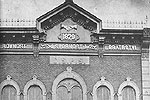
Lower
West Side (continued)
More than any other ethnic group in Chicago, Bohemians tended
to be socialists and freethinkers, and they were closely identified
with the "Battle of the Viaduct" on July 26, 1877 when
Chicago police and U.S. soldiers killed nearly thirty workers
and injured two hundred persons, among them women and children.
According to Schneirov, Bohemian lumbershovers spontaneously joined
the railroad strike of 1877, expanding it beyond the Michigan
Central railroad yards near the lakefront to the area west of
the Chicago River. Bohemian women filled their aprons with stones,
thereby aiding their husbands and sons in the conflict with the
police and militia. At one door and sash factory on 22nd Street,
Bohemian women "stoned the hated bluecoats till they dispersed."
So intense were the confrontations between workers and police
on Chicago's Lower West Side that Blue Island Avenue came to be
known in labor circles all over the nation. Built as a plank road
in 1854 linking Western Avenue to downtown Chicago, Blue Island
Avenue was filled in with cinders from nearby factories, hence
its name "Black Road." In 1877 and again in 1886, battles
between police and strikers outside the McCormick Reaper Works
gave new meaning to the sobriquet "Black Road."
In addition to the struggle for economic survival, religious
differences shaped the Bohemian community in Pilsen. Freethinkers,
Catholics, and Protestants all formed their own institutions
, especially schools and sokols where Czech
values could be transmitted to American-born children (See
Fig. 1). The Bohemian
community also supported a wide range of newspapers, from the
liberal Czech Svornost to the Socialist weekly, Spravedlnost and
the Catholic daily, Narod.
By the 1880s, an estimated 45,000 Bohemians lived in the area
bounded by 16th Street, Halsted, 20th Street (Cullerton), and
Ashland Avenue. One of Pilsen's first Bohemian institutions was
St. Procopius parish, established in 1875. So quickly did the
membership of this congregation grow that within eight years they
were able to build and dedicate the massive Romanesque church
which stands today at the northeast corner of 18th and Allport,
a link with the neighborhood's Bohemian past.
Not only did St. Procopius parish overshadow the older Irish
parish of Sacred Heart at 19th and Peoria, but it became the "mother
church" of Chicago's West Side Bohemian parishes. As early
as 1888, Bohemian Benedictine priests from St. Procopius established
a mission at 18th Place and Paulina which developed into the flourishing
parish of St. Vitus. More than just a neighborhood church, St.
Procopius was the largest Bohemian congregation in the United
States, and it supported an abbey, the printing plant for Narod,
a large grammar school, and a boys high school (1887), which would
later evolve into Illinois Benedictine College in Lisle.
«
previous
3
of 13
next
»
|
 |

|
 |


Figure
1: The lodge headquarters of the Czech Slavic Benevolent Society
(CSPS), built in 1879 at 1226 W. 18th Street. »
|